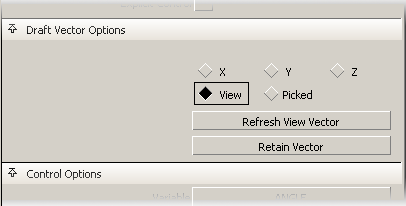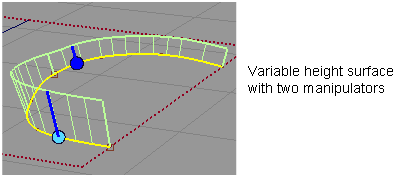Creates a single ruled surface from a group of tangent-continuous surface curves by pulling a surface at an angle to the normal of the original surface(s), or at an angle to a pull vector.
See Pull surfaces from curves of an existing surface.
The Multi-Surface Draft tool uses surface edges, curves on surface or isoparametric curves, to create a ruled surface that extends away at an angle to the original surface(s).
You can build a single surface across all of the input surface curves, provided that they are tangent continuous.
 and Surfaces > Draft Surfaces > Draft/Flange
and Surfaces > Draft Surfaces > Draft/Flange  .
.

Normal – Creates a surface that extends away at a given angle from the normal of the underlying surface(s). By default, the new surface is normal to the underlying surface(s).
Draft – Creates a surface that extends away at a given angle from a specified pull direction vector. By default, the surface is parallel to the pull vector.

The initial angle between the new surface and the normal of the original surface (Normal type), or pull vector (Draft type). The default is 0.0. You can also change this value using the angle/height manipulator when you use the tool. (See Variable option below).
The initial height of the surface from the original curves. You can also change this value using the angle/height manipulator when you use the tool. (See Variable option below).
If you choose Single surface, a single surface is built. If you choose Multiple surfaces, a separate surface is created for each of the input curves you selected, and the surfaces are grouped.
Reverses the direction of the new surface(s).
This option only appears if Surface Type is set to Multiple surfaces. If it is checked on, each surface will be a Bézier patch.
Bézier patches have a single span, and their maximum degree in the U direction is set through the Explicit Control section. The default is degree 5.
Turn on this option if you want to specify the exact degree and maximum number of spans in the new surface.
Degree of the new surface in the U direction. (The surface is always of degree 1 in the V direction.) Enter a whole number from 2 to 9. This option only appears if Explicit Control is checked.
If Surface Type is set to Multiple surfaces, this value specifies the maximum number of spans for each draft surface. If Surface Type is set to Single surface, it specifies the maximum number of spans for each piece of the original surfaces.
This option only appears if Explicit Control is checked, and Bézier Surfaces is not checked.
These options only apply when Type is set to Draft.

Select one of these to specify a pull direction along that axis.
Select this option to specify a pull direction normal to the current view. The vector is not drawn in the view windows.
If the current view is changed, click Refresh View Vector to update the vector.
Selecting this option lets you specify the name of an existing vector in the Picked Vector field, or pick the vector in the view. This vector defines the pull direction.
This button only appears if View is selected. Click it to update the vector if the view has been modified.
Click this button to create a vector construction object in the view windows. Unless you do this, the vector direction you specified is used by the tool, but you will not see and be able to re-use the vector.
Gives you the ability to interactively modify the angle or height of the new surface by clicking and dragging the manipulators.
Angle – Allows you to adjust the angle of the surface. You can create any number of manipulators by clicking along the input curves, and then adjust the angle individually at those points.
Height – Allows you to adjust the height of the surface. You can create any number of manipulators by clicking along the input curves, and then adjust the height individually at those points.
If this box is checked, selecting a surface curve also selects all other surface curves that are tangent continuous with it.
Turn on this option to have the new surface automatically re-calculated and displayed as you modify the option values or make adjustments to the manipulators.
If it is off, you must press the Recalc button in the lower right corner of the window to update the surface(s).
Turn on this option to see the level of continuity between the newly created surface(s) and the original surface(s):
P – Positional continuity
T – Tangent continuity
C – Curvature continuity
Using the manipulators to control angle and height
The variable parameter (Angle or Height — as specified by Variable in the option window) is controlled using a set of manipulators in the modeling window. Only one of the parameters can be varied: the other one is held constant.
Each manipulator consists of two handles — the curve slider and the value handle — only one of which can be active at a given time. The active handle is shown in light blue. The curve slider, a "ball" sliding along the input curve, indicates the position on the curve where the value applies. The value handle, a straight “spike”, controls the value of the parameter(angle or height) at this point.
The value of the active handle is shown on the prompt line.

For all of the following
operations, use the  , unless stated otherwise.
, unless stated otherwise.
 . Alternatively, activate
the slider ball and type in the position (in the range from 0 to
1) along the curve.
. Alternatively, activate
the slider ball and type in the position (in the range from 0 to
1) along the curve.
 -right click it.
-right click it.
If a single manipulator is used, the parameter is constant, and its value can also be adjusted in the option box. As soon as another manipulator is added, the value in the option box is grayed out.